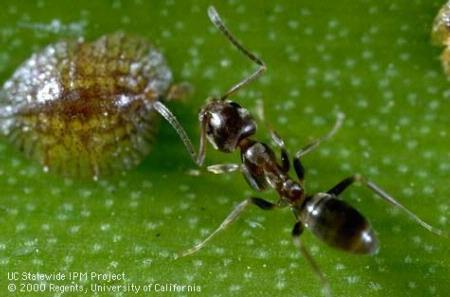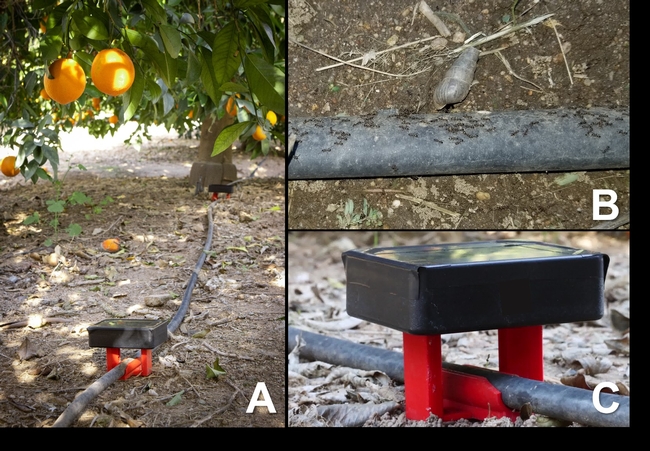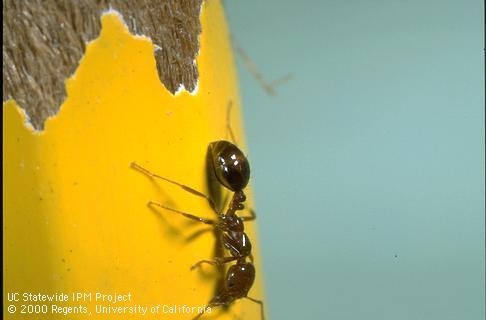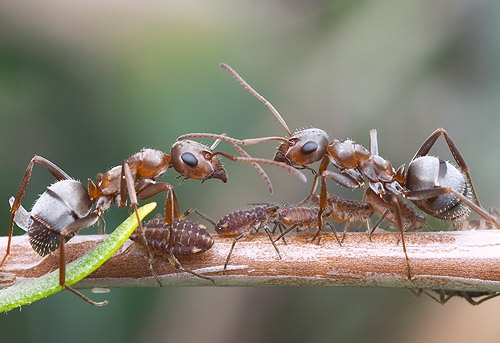
Posts Tagged: Argentine ant
Synergizing Argentine Ant Control
Synergizing IPM of Argentine ant and biocontrol of sap sucking pests with biodegradable hydrogels, infra-red sensors, and cover crops in commercial citrus orchards
Ivan Milosavljevi?, Department of Entomology, University of California, Riverside, CA
Nicola A. Irvin, Department of Entomology, University of California, Riverside, CA
Kelsey A. McCalla, Department of Environmental Science, Policy, and Management University of California, Berkeley, CA
Mark S. Hoddle, Department of Entomology, University of California, Riverside, CA
Argentine Ant control critical for IPM in citrus groves
The invasive Argentine ant (AA) (Linepithema humile) is a serious impediment to the biological control of sap sucking pests (SSPs) in citrus orchards (Hoddle et al. 2022). SSPs include mealybugs, scales, aphids, and Asian citrus psyllid (ACP), the vector of a bacterium that causes HLB, a lethal citrus. AA protect >85% of SSPs and >55% of ACP colonies from their natural enemies which exacerbates pest infestations. In return for protection from natural enemies, ants are rewarded for this service by SSP's through the provision of a sugary waste product, honeydew, which ants harvest and return to nests to feed brood and queens. Contact sprays for AA and SSP control applied to soil, trunks, and foliage kill natural enemies, cause secondary pest outbreaks, and increase the likelihood of insecticide resistance developing. IPM of AA and SSPs requires an accurate method of assessing pest densities so that appropriate treatment decisions can be made, precision delivery of insecticides to kill foraging AA is necessary if natural enemies are to be preserved, and enhancement of natural enemies through conservation biocontrol can increase the efficacy of free pest control services provided by natural enemies in citrus orchards.
Enhancing and automating Argentine ant monitoring using infra-red sensors and the internet of things
Efficient and accurate pest monitoring is a key component of IPM programs. There are currently no standardized monitoring programs for assessing AA infestation levels. Visual ant counts are time consuming, tedious, and become inaccurate when counting fatigue sets in. To remedy this problem, we developed and field-tested infrared sensors (IRS) that clamp to irrigation lines to automate ant counts . AA use irrigation lines as super-highways to rapidly move across the orchard floor to reach pest infested citrus trees. Statistical analyses indicated that it is possible to predict with about 85% accuracy the average number of ants ascending tree trunks based on the average number of ants running on irrigation lines. Thus, ant counts made by IRS on lines can be used to accurately predict the average number of ants ascending tree trunks in citrus orchards. Ant counts made by IRS are relayed wirelessly to the cloud where average AA densities are reviewed on an App that is loaded onto a smart device. IRS's eliminate the need for humans to monitor ant densities, they provide block specific estimates of AA activity, and they can potentially operate 24/7/365! We are currently determining the minimum number of IRS needed per acre to estimate ant densities with fixed levels of precision (e.g., 85, 90, 95% accuracy).
Based on accurate ant density estimates treatment decisions can be made, and importantly, just the areas of the orchard exceeding acceptable ant densities can be identified and treated (Schall et al. 2018). Focused applications reduces insecticide use, saves money, and minimizes adverse effects of insecticide use on beneficial non-target species, like natural enemies (McCalla et al. 2020). As part of an AA IPM programs, treatment decisions require action thresholds and when AA densities exceed the action threshold, treatments can be initiated. At this time, there are currently no established action thresholds for AA in citrus. This is an important problem we are currently working on.
(A) Infra-red sensor (IRS) clamped onto an irrigation line in a commercial citrus orchard. (B) Argentine ants use polyethylene irrigation lines that sit on the soils surface as “super-highways” to move from underground nests to tree canopies where they collect honeydew. (C) Close-up of IRS counting Argentine ants running on irrigation lines. (Photos by Mike Lewis and Mark Hoddle, UC Riverside).
Hydrogel baits provided targeted and highly effective Argentine ant control in citrus orchards
Chlorpyrifos, the industry standard insecticide for AA control, was recently banned in California because it poses significant risks to human health. In response to this ban, we developed biodegradable hydrogel beads (HGBs) as an alternative highly specific treatment that targets AA. HGBs contain a 25% sucrose solution, and an ultra-low dose of insecticide (0.0001%). HGB's are applied to the ground under citrus trees and spread out so foraging AA can rapidly find them. Ants imbibe sugar water laced with insecticide, return it to the nest to feed brood and queens which kills them. Consequently, HGB's may provide a superior alternative to plastic liquid bait stations for delivering toxins to AA as bait stations are cost-prohibitive for mass use in orchards. Our lab has demonstrated that both thiamethoxam and an organically approved spinosad formulation are highly efficacious when delivered to AA using HGBs infused with sugar water that is laced with insecticide. Within 2-3 days of HGB applications, AA colonies collapse, and AA densities are reduced by >95% in comparison to untreated plots. Rapid (< 5 days) long term (> 3 months) control of AA results from repeated HGB applications (~3-4 applications ~3 weeks apart over summer). Once AA are controlled long-term reductions in densities of SSPs in citrus results because natural enemies are able to more effectively control SSP's in the absence of AA. We are currently determining the minimum amounts of HGBs, and frequency of applications needed to optimize AA control at the lowest costs to growers.
Using flowering plants to enhance natural enemies of ACP and SSPs in citrus orchards
Our previous work has shown that natural enemies, especially hover flies (syrphids), respond strongly to flowering alyssum (Lobularia maritima) and buckwheat (Fagopyrum esculentum). Field work has also shown that ACP in citrus plots with flowering plants suffer significantly greater levels of natural enemy attack, especially by predatory hover fly larvae, when compared to plots lacking flowering plants. Hover fly larvae are dominant predators attacking ACP nymphs and other SSPs in citrus (Kistner et al. 2016, 2017). Tamarixia radiata, a tiny parasitic wasp has been imported into California from the Punjab of Pakistan to attack ACP nymphs also feed from buckwheat flowers. We have also found that hoverflies in southern California are most active in spring and fall and this is when flowering plants are most beneficial to them. This finding is important as ACP (and SSP) populations are greatest in spring and over fall also. Sowing flowering plants late-February and re-sowing in early-September would synchronize hoverfly activity with ACP population increases. We are currently assessing the efficacy of flowering plants in multiple commercial citrus orchards to the magnitude of reductions in populations of ACP and SSP densities when cover crops are present and absent.
Take home messages
IPM of AA and SSP's in citrus, include ACP, requires new and innovative approaches if long-term sustainable management is to be achieved. To achieve this, we are working on developing a package that combines three tools, HGBs, IRS, and flowering plants that enhance monitoring of AA (IRS), provides targeted highly specific control of AA (HGBs) that in turn relieves natural enemies from pressure of foraging ants which permits them to increase the free pest management service that they provide in citrus orchards. These agroecosystem services provided by natural enemies can be further enhanced through resource provision, cover crops, which provide pollen and nectar to natural enemies. This combination of tools, IRS, HGBs and cover crops, synergizes IPM of AA and biocontrol of sap sucking pests infesting California-grown citrus.
Control Argentine Ant and Biocontrol Can Really Work
Argentine Ant is a very aggressive invader that disrupts native ant populations and at the same time disrupts biocontrol agents that help control, such pests as scale, aphids and mealy bugs in citrus and other tree crop species. They defend these sugar producing sources of energy from attack by predators and parasites, like parasitic wasps and predatory assassin bugs and lady bugs. They increase the threat of Asian Citrus Psyllid and HLB by protecting the psyllid from attack by parasitic Tamarixia.
A careful, well placed chlorpyrifos spray has been used to control Argentine ants. A trunk spray and/or spray on irrigation lines has disrupted their activity with minimal impact on beneficials. This protectant spray keeps the Argentine ants out of the canopies and allows the beneficials access to the pests. Controlling this one species, can have significant impact on biocontrol and the whole need for controlling pests.
Chlorpyrifos is a pesticide that might lose registration and other materials and techniques have been examined over the years as a replacement. A recent procedure has been proposed and used successfully on Santa Cruz Island to control introduced Argentine ants. The ant has caused tremendous disruption in biocontrol and it appears to have been controlled by this new technique. We are in the process of evaluating it's use in citrus. The application technique, costs and materials would need to be modified for use in citrus orchards. The current procedure would not be considered an organic practice since the pesticide material is not registered organic. It might be possible to use an organically registered material in the future.
Protocols for Argentine ant eradication in conservation areas
L.Boser1,C.Hanna2,D.A.Holway3,K.R.Faulkner4,I.Naughton3,K.Merrill5,J.M.Randall1,C.Cory1,D.-H. Choe6 & S. A.Morrison
Journal of Applied Entomology
http://onlinelibrary.wiley.com/doi/10.1111/jen.12372/full
The Argentine ant (Linepithema humile) is a widespread, abundant and ecologically disruptive invader that is present throughout major portions of coastal California and on half of the California Channel Islands. On Santa Cruz Island, the Argentine ant had invaded about 2% of the island's area in four distinct locations as of 2012. Given the negative ecological effects resulting from Argentine ant invasions,we sought to develop a cost-effective method of eradication. Here, we describe the results of large-scale, field-tested methods for Argentine ant eradication and post-treatment detection. Our eradication protocol employs a novel toxicant-delivery system: an aqueous solution of sucrose and 6 ppm of thiamethoxam mixed with hydrating polyacrylamide beads. Ants feed on the solution present on the bead's surface for about 24h after which time bead dehydration prevents feeding. We distributed hydrated beads by helicopter over 74 ha of infested areas plus a 50-m buffer on 14 occasions between June 2013 and September 2014. Treatments reduced Argentine ant activity to subdetectable levels within four months. In 2014, we conducted a high-intensity detection protocol using lures (n = 55 363) in areas treated in 2013.This effort did not detect Argentine ants. In 2015, we conducted a medium-intensity detection protocol using lures (n=2250) in areas treated in 2013 and 2014 but not searched in 2014; this sampling effort did not detect Argentine ant activity except for a single remnant infestation (c.0.3ha in area),which was retreated in2015.Thec ost of treatments was approximately $1400 per ha; this cost is comparable to other ant eradication efforts. The cost of our preferred detection method, which used lures spaced every 10m,was $500 per ha.These results demonstrate sufficient protocol efficacy to justify expansion of treatments to other infested areas in ecologically sensitive areas.
Photo: Argentine ant and scale

argentine ant and scale
Argentine Ants
There are numerous species of ants present in citrus orchards, however, the most common are the Argentine ant (southern and coastal California), the native gray ant (San Joaquin Valley) and the southern fire ant (statewide). The red imported fire ant has been found in Southern California, but is not yet established in citrus orchards. It is important to identify the primary ant species in the orchard, because management tactics depend on which ant species is present.
The Argentine ant, is a small, uniformly deep brown ant. Worker ants travel in characteristic trails on trees, the ground, or irrigation lines and build their nests underground. Ant populations peak in mid-summer through early fall.
The southern fire ant is light reddish brown with a black abdomen. These ants build nests of loose mounds or craters near bases of trees, do not aggregate in colonies as large as those of the Argentine ant, and will sting and bite.
Native gray ants are gray and considerably larger than the other two species. They nest in topsoil or under rocks and debris and move in irregular patterns. In contrast to Argentine and fire ants, the native gray ant is solitary and its importance in disrupting biological control is often underestimated.
Red imported fire ant is new to California and can make large, dome-shaped mounds. They feed on almost any plant or animal material.
Damage
Most ant species feed on honeydew excreted by various soft scales, mealybugs, cottony cushion scales, whiteflies, psyllids, and aphids. As part of this relationship, they protect these pest insects from their natural enemies, thus interrupting biological control. They also protect some non honeydew-producing pests, such as California red scales.
Argentine and native gray ants are the most common ant species that aggressively protect pest insects. In addition, Argentine ants and fire ants can plug up irrigation sprinklers. Fire ants directly damage citrus by chewing twigs and tender bark of newly planted trees; they also sting people working in the orchard and may cause allergic reactions.
No effective natural enemies of ants are known.
Cultural Control
Skirt prune trees, i.e., remove branches within 12 to 30 inches of the ground, and apply sticky material to the trunk to prevent access to the trees by ants. Use polybutenes, as oil-based materials may cause phytotoxicity and should not be used.
The application of sticky polybutene materials directly to the trunk of citrus trees can cause bark cracking, especially if multiple applications are applied to the same area of the trunk, the area is exposed to sunlight (topworked trees), or both. The sticky material can be applied on top of a tree wrap or a base layer of latex paint. Young trees, which have a very thin cambium layer, are most susceptible to damage.
Sticky material should last from 1 to 4 months and will also prevent the access by Fuller rose beetles. If the sticky material contains tribasic copper sulfate, it will also control brown garden snails. The persistence of sticky material can be increased by applying it higher above the ground to reduce dust and dirt contamination and to decrease irrigation wash-off.
Baits
Argentine ant adults are liquid-feeding only and have physical digestive "blocks" in the mouth and gut to prevent them from swallowing and digesting solid food particles. They may bring back solid food to the colony to feed the brood (but solid-food digestion not been confirmed in Argentine ant brood), or harvest the bodily fluids inside of insect prey/moisture in food items. Dry insects or food items are of little use to them, even though they may pick these things up. Feeding studies have shown ants feed several times faster on liquids than gels and gels than solids. This faster feeding resulted in much higher toxicity with liquid. Gel was intermediate, and solids provided the lowest control.
Put out bait in the shade to increase feeding and overall kill. You do not need to obscure it. The soil temperature and moisture are going to be more moderate in the shade, particularly under the canopy. This is the environment the ants will prefer to feed in. There will be less evaporative loss in the shade, as well. Sometimes when the toxins become too concentrated they are less attractive to the ants. The other issue is that many toxins (like borax products) may photodegrade at a faster rate in direct sunlight.

aRGENTINE ANT
Ants- they keep coming back
Many growers seem like they will never win the never ending battle with ants, they're everywhere! Conversely, ants travel through soil and help loosen it improving quality, allowing water, air, and nutrients to flow freely through it. They also decompose dead plant and animal matter and can even feed on other insects. However, ants sometimes chew crop twigs and tender bark, damage irrigation tubing, and can annoy and harm workers. You can find ants traveling alongside your trees, the ground, or irrigation lines and build their nests underground.

The southern fire ant (Figure 2.) is light reddish brown with a black abdomen. Active in the morning and early evening and do not trail. May swarm out of nests if disturbed and can inflict painful stings.
Native gray ants (Figure 3.) are gray and considerably larger than the other two species. They nest in topsoil or under rocks and debris and move in irregular patterns. In contrast to Argentine and fire ants, the native gray ant is solitary and its importance in disrupting biological control is often underestimated. Red imported fire ant is new to California and can make large, dome-shaped mounds. They feed on almost any plant or animal material.
Avocados & Citrus
Ants are pests primarily because they disrupt biological control of other pests, especially that of the Tamarixia radiata, which is a natural predator for the Asian Citrus Psyllid. Ants are also a big problem in young trees causing trunk damage as well as feed on honeydew excreted by various soft scales, mealybugs, cottony cushion scales, whiteflies, and aphids. As part of this relationship, they also protect these insects from their natural enemies, thus interrupting biological control of the honeydew-producing pests. In the process of keeping most natural enemies away, they also protect other pests, such as California red scale, that profit from the lack of natural enemies. Argentine and native gray ants are the most common ant species that aggressively protect pest insects. In addition, Argentine ants and red imported fire ants can plug up irrigation sprinklers. Red imported fire ants directly damage plants by chewing twigs and tender bark of newly planted trees; they also sting people working in the orchard and may cause allergic reactions and sometimes trips to the emergency room.
For more information on ants in avocados, please visit the UC IPM website:
http://www.ipm.ucdavis.edu/PMG/r8301311.html.
For more information on ants in citrus, please visit the UC IPM website:
http://www.ipm.ucdavis.edu/PMG/r107300211.html.
Management
Ant management requires diligent efforts and the combined use of mechanical, cultural, sanitation, and often chemical control methods. Ant populations peak in mid-summer through early fall, therefore the best time to bait is late winter to early spring when ant numbers are relatively low. Bait effectiveness varies with ant species, availability of alternative food, active ingredient, type of bait, and the time of year. To determine which bait to use, offer a small quantity of each of several baits and observe which is preferred by the ants.
For information on ants in general, please visit the UC IPM website:
http://www.ipm.ucdavis.edu/PMG/PESTNOTES/pn7411.html.




